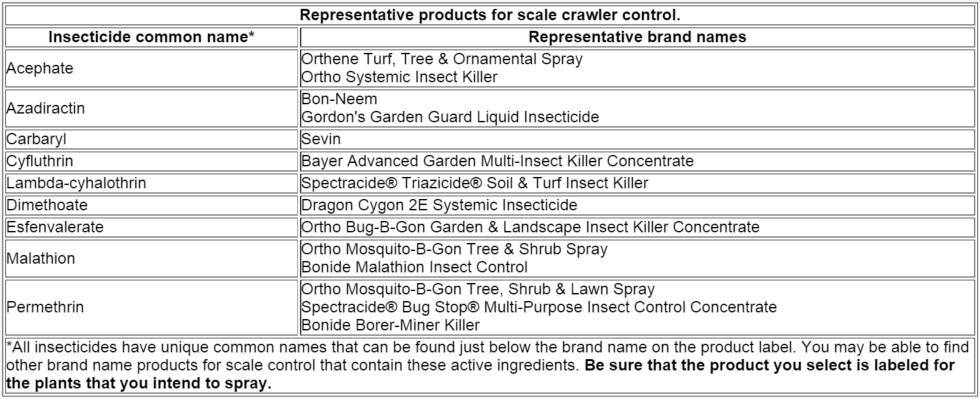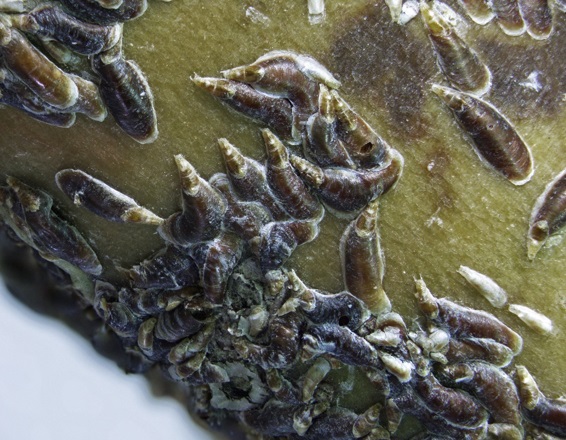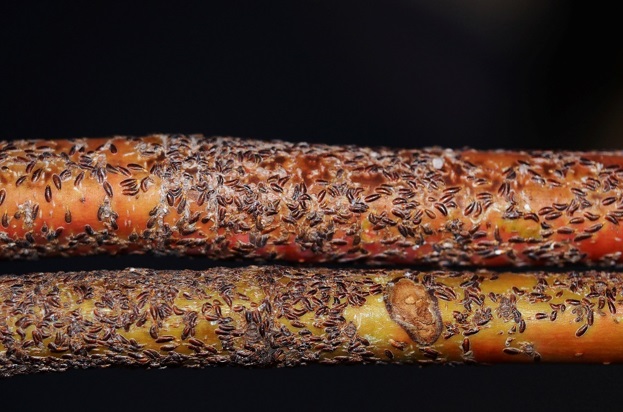Oystershell Scale
ENTFACT-433: Oystershell Scale | Download PDF
By Jonathan L. Larson, Extension Entomologist and Lee Townsend, Extension Specialist Emeritus
University of Kentucky College of Agriculture
Oystershell Scale Fast Facts
- Oystershell scale is an armored scale pest that can reach a 1/8th of an inch in length. They get their name from their brown, elongated wax cover that resembles an oyster or clam shell.
- This pest has an extremely wide host range, but commonly infested plants include lilac, ash, dogwood, maple, poplar, and willow.
- Branch dieback is a common symptom with oystershell scale and if populations are not dealt with, plant mortality is a possibility.
- Management can depend on crawler control using contact insecticides or organic options like horticultural oil or insecticidal soap or can rely on a systemic treatment of dinotefuran.
Oystershell scale can be initially hard to find due to their small size and coloration. They do resemble an oyster shell in shape. (Photo by Jim Kalisch, University of Nebraska-Lincoln).
Potential Hosts
Oystershell scale has a broad host range of over 130 different species of plants. Fruit trees like apple can be infested. More commonly, they are found on ornamental plants such as ash, lilac, dogwood, maple, aspen, and cotoneaster.
Symptoms and Pest Description
This armored scale can be found throughout the plant, on branches and trunks. Scale insects are sucking pests, they use long needle-like mouthparts to suck fluids out of plants in order to feed. Infested plants may display branch dieback, bark cracks, and leaf yellowing.
The mature scale’s waxy outer shield is what gives the species its name. They are about 1/8th inch long, with an elongated shape that resembles an oyster. They are dark brown or gray and blend in well with the bark of their host. The crawler stage is small (about 1/25th inch long) and yellow while the eggs are small white spheres found under their mother’s waxy coating.
Life Cycle in Kentucky
Oystershell scales overwinter as eggs under the waxy cover of the female. Eggs hatch in mid- to late April and the crawlers are active into early May. The crawlers will find a suitable feeding site and then settle onto the plant. They will gradually develop and increase in size. The females produce their eggs around the end of summer or the beginning of the autumn. There is one generation each year.
Oystershell scales can be hard to discover and as populations build, they will cause increasing stress to the plant. (Photo by Jim Kalisch, University of Nebraska-Lincoln).
Management
Scales tend to thrive on stressed plants. Following a recommended fertility program and watering regime will promote plant health. However, over-fertilization favors scale buildup. If practical, improve plant sites to reduce stress and promote growth. You can prune out small infestations to try and eliminate the issue or prune out sections of a large scale problem in order to make chemical control more feasible.
There are two options when considering insecticide management of oystershell scales, doing a systemic treatment or treating the crawlers directly. Whichever you choose, management may take repeated applications over a couple of growing seasons.
Treating with Systemic Insecticides
Dinotefuran (Orthro Tree & Shrub is one possible trade name) can be used against armored scales such as the oystershell scale. A systemic insecticide helps to give you control without reliance on broadcast sprays on the plant. This helps keep insecticide residues contained within the plant you wish to protect and helps to ensure the product will affect the pests you are targeting. Dinotefuran should be applied after the tree has bloomed in order to avoid causing undue harm to pollinating insects.
Treating Crawlers Directly
Crawlers are the most susceptible to control stage of a scale insect’s life. Once they begin to coat themselves in their waxy armor, insecticide applications will be ineffective. You can visually check in May (phenologically, egg hatch match the blooming of Miss Kim Manchurian Lilac (Syringa pubescens) ) or you can place pieces of black electrical tape (sticky side out) or double-sided tape near scale populations and monitor the tape for the crawlers and treat following the initial find.
Horticultural oils kill by suffocation or after penetrating over-wintering stages of the insect. Consequently, they may not be effective where several layers of scale coverings have accumulated. Insecticidal soaps are long chain fatty acids that kill susceptible insects through direct contact. Like horticultural oils, they require thorough coverage. Soaps leave no residue so repeated applications may be needed for some pests. These products may burn the foliage of sensitive plants, such as Japanese maple, so check the label for information about the plant species that you intend to treat.
A variety of natural and synthetic insecticides are labeled for use as sprays to control scale crawlers on landscape trees and shrubs. While the residual life of these products is generally longer than oils and soaps, timing, coverage, and precautions on damage to some plant species are very similar to those for oils and soaps.
Below are some options for scale insect crawler control.

Evaluating Control
The success or failure of control efforts may not be readily apparent but here are some things to check.
- Live scales should produce a liquid when mashed, dead scales will be dry and not "bleed" when crushed.
- New foliage should have a healthier appearance once the scale burden has been removed. Buds should break a little earlier than when the plant was infested and expanded leaves should have normal color and turgor.
Revised: 2/21
CAUTION! Pesticide recommendations in this publication are registered for use in Kentucky, USA ONLY! The use of some products may not be legal in your state or country. Please check with your local county agent or regulatory official before using any pesticide mentioned in this publication.
Of course, ALWAYS READ AND FOLLOW LABEL DIRECTIONS FOR SAFE USE OF ANY PESTICIDE!
Images: University of Kentucky Entomology


